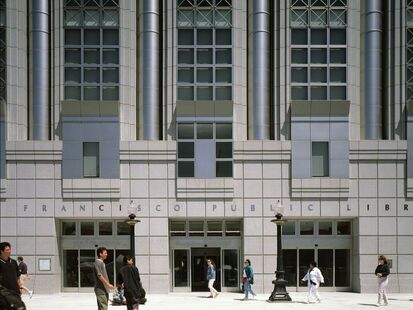 By 1973, City Librarian Anderson resigned. His efforts to increase outreach to underserved neighborhoods and a new Main Library to seemingly endless budget-cutting, more studies about the state of the old building, and frustrated patrons on all sides. A new Main Library seemed a longshot, with even City Librarians, Commissioners, and Mayors skeptical of the project. But Friends never gave up hope and pushed ahead with three strategies:
Chapter 4: Defending the location: The fight for Marshall Square With a controversial appointment by Mayor Joseph L. Alioto, Kevin Starr began his tenure as City Librarian in 1973. The selection was controversial because Starr did not hold a Library Science degree at the time of his appointment, but he did consistently advocate for increased funding for a new Main Library. Starr's first request for an increased budget was immediately rejected at City Hall and then in April 1974, in a blindside, Starr and Library Commission President, Edward Callanan, were called to the Mayor's office. Mayor Alioto revealed that he was in private discussions with the city's most significant philanthropists who would help fund a performing arts center for a symphony at Civic Center instead of a library, introducing them on the spot to Samuel Stewart, Gwinn Follis, and Harold Zellerbach. (Marshall Square denotes the plaza that connects Market Street to the current City Hall.) It was a classic confrontation between downtown interests and wealthy supporters versus a motley crew of artists and neighborhood groups galvanized by the Friends and its advocacy arm, Keep Libraries Alive! Friends lost badly at the first Planning Commission hearing where the performing arts center plan was endorsed 7-0. As the battleground shifted to the Board of Supervisors, Starr hired attorney William Coblentz to help with a behind-the-scenes compromise. With help from Supervisor Ronald Pelosi, they crafted a deal that included the Board of Education, which at the time was engaged in their own dilemma about what to do with their property on Van Ness Avenue. In the end, the Board of Education turned their Commerce High School athletic fields over to the symphony and the Library retained Marshall Square. Chapter 5: Finding the public investment: Passing the bond measures As George Moscone entered his mayoral term in 1976, the fallout from Proposition 13 continued to choke local governments in maintaining the public infrastructure. The newly appointed City Librarian in 1997, John Frantz, encountered the same rejections in successive budget seasons. After the tragic assassination of Mayor Moscone and Supervisor Harvey Milk, Frantz served his tenure for the duration of the Diane Feinstein’s administration, where he found an engaged and pragmatic advocate for libraries. Grappling with a branch-heavy system, particularly in the city's northeastern quadrant, Frantz attempted to close 14 branches in 1978. When greeted by groups of yelling library lovers in front of all of them, he closed none. He still went on in 1981 to commission Lowell Martin of Columbia University to study the economics of a branch system. The report again recommended closing branches and converting others into "supermarket libraries" with a comprehensive range of services and special-purpose branches. When Frantz took the draft report to Mayor Feinstein, he recalls: She was lecturing us on the importance of libraries and on the importance of having all of the branches open all of the time with real librarians. She got herself into such a froth that she increased our budget for 1982-1983 by about 30% in order to leave things alone. This was short-lived. Feinstein focused on the masterplan for the Civic Center, insistent that a Main Library serve as an anchor there. Even as the public and private sectors spared no cost to build the new Symphony Hall and the War Memorial Building, that same spirit and wealthy power structure did not yet support the public Library. Ambition was high at Friends however, where the Board had already hired Marilyn Smulyan to coordinate a Campaign for the Main and dared to offer an alternate masterplan for Civic Center. In April 1985, James Haas, a member of the Board of Directors, wrote to Mayor Feinstein recommending that a new library be built on the other side of Fulton Street and that the Asian Arts Museum is moved into the existing Main building. While initially unreceptive in a first meeting with Commission President Edward Callanan, John Frantz, Marjorie Stern, and Mary Louise Stong, Mayor Feinstein soon dispatched her Deputy Mayor Peter Henschel to form a task force around the idea, obtaining the willing agreement of the Asian Art Museum Board and the eventual approval of the Board of Supervisors. But which side of Marshall Square, and how would the community get around the central problem of paying for a library in either location? Several fortuitous developments started to fall into place:
Election victory! While almost no one believed the voters would approve such a whopping sum, Friends' polling showed that slightly more than two-thirds of voters favored the bond. Friends hired consultant Dick Pabich, who led the Proposition A – Yes for Libraries campaign. Pabich focused on securing the natural base of support in the liberal activist community and targeted conservative home-owning voters. Using precinct records from a recent school board election, volunteers knocked on doors engaging in one-on-one conversations and made 40,000 phone calls. On election night, the bond passed with 78% of the vote. Coming next, Chapter 6: The Library Foundation and the inclusive and unifying philanthropic campaign for the Main. Also, check out Chapter 1, Chapter 2, and Chapter 3.
11 Comments
|
AuthorWrite something about yourself. No need to be fancy, just an overview. Archives
May 2024
Categories |
ADMINISTRATIVE OFFICES &
|
Get INvolvedContact UsTax ID Number: 94-6085452 ©2021 Friends of the San Francisco Public Library
|
SUBSCRIBE TODAY FOR UPDATES!
|
